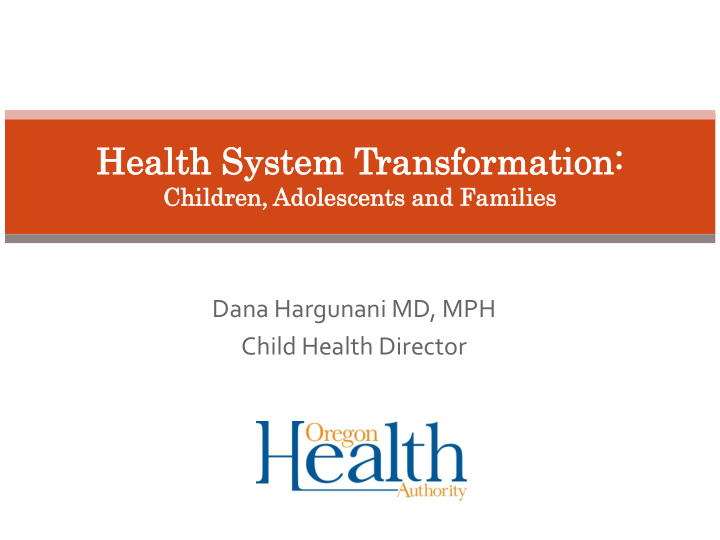



Hea ealth lth Sy System tem Tra ransformatio nsformation: n: Children, Ch dren, Ad Adolescen escents ts and Families es Dana Hargunani MD, MPH Child Health Director
Healthy Kids: The Foundation Over 118,000 children have been enrolled in Healthy Kids since 2009 Improvements seen for Healthy Kids enrollees Access, Utilization, Costs & Financial Strain, Health Outcomes Reduction in racial/ethnic disparities Successful outreach model has laid foundation for Oregon ’ s health insurance exchange
Triple Aim: A new vision for Oregon www.health.oregon.gov
Changing health care delivery Benefits and Metrics: standards One global budget services are for safe and that grows at a integrated and effective care fixed rate coordinated Local accountability for Local flexibility health and budget www.health.oregon.gov
Health System Transformation What does it mean for children and adolescents? Integration of behavioral, mental and physical health care More focus on preventive care Local governance allows focus on local needs Accountability for health outcomes Alignment with education system transformation www.health.oregon.gov
Patient and Family Centered: Oregon’s Primary Care Home (PCPCH) Model of Care Oregon’s PCPCH Model is defined by six core attributes, each with specific standards and measures set thru a public process: Access to Care – “Be there when we need you” Accountability – “Take responsibility for us to receive the best possible health care” Comprehensive Whole Person Care – “provide/help us get the health care and information we need” Continuity – “Be our partner over time in caring for us” Coordination and Integration – “Help us navigate the system to get the care we need safely and timely Person and Family Centered Care – “ recognize we are the most important part of the care team, and we our responsible for our overall health and wellness ”
Access and Quality of Care Oregon ’ s Measurement Strategy : Informed by the legislatively mandated Scoring & Metrics Committee; Negotiated with CMS Many metrics relevant to children and youth: Adolescent well visits ADHD treatment and follow-up Mental/physical health assessments- children in foster care Developmental screening Screening for clinical depression and follow-up plan Alcohol or other substance misuse (SBIRT) www.health.oregon.gov
Affordable Care Act: 2014 Protecting Healthy Kids enrollment gains ACA Maintenance of Effort Requirements for Medicaid and Children ’ s Health Insurance Program (CHIP) Working with Oregon ’ s Health Insurance Exchange to ensure seamless transfers between Medicaid, CHIP and the Exchange Outreach services provide integrated system for children and their parents www.health.oregon.gov
Aligning Education and Health System Transformation Starting with Early Learning www.health.oregon.gov
Education System Transformation By 2025: 40% of adult Oregonians have earned a bachelor ’ s degree or higher 40% of adult Oregonians have earned an associate ’ s degree or post-secondary credential The remaining 20% have earned a high school diploma or its equivalent Early Learning System (0-6) goals: Children enter kindergarten ready to succeed Children are raised in stable and attached families Systems and services are coordinated www.health.oregon.gov
Early Learning System Early Learning Council – Policy body: early learning system (0-6) Early Learning Division (Department of Education) – Oregon Head Start Prekindergarten – Home Visiting (Healthy Families Oregon) – Children ’ s Relief Nurseries – Childcare – Hub support and various early learning initiatives Early Learning System – All early learning, human services and health programs/services that support kindergarten readiness www.health.oregon.gov
Kindergarten Assessment A snapshot in time: A look forward so that teachers and schools can tailor their instruction to individual student needs A look back to assess whether community supports and services are meeting the needs of children and families Implementation: 2012: Assessment tool adopted (literacy, math and social emotional development components) 2012-13: Pilot- 16 schools, 1228 students Fall 2013: Statewide, first 6 weeks of school (ODE)
Hubs • Establish Early Learning Hubs to coordinate services for children • Local communities share collective responsibility for outcomes of Oregon ’ s young children • Build on existing community resources to make system change to get better results, especially for at risk children • Up to 7 in Round 1; Up to 16 Total www.health.oregon.gov
Joint ELC/OHPB Subcommittee • Chartered by the Early Learning Council and Oregon Health Policy Board, December 2012 • Strawperson proposal: • Alignment of health and early learning policy and service delivery • Timeline and process for establishing kindergarten readiness as a shared outcome • Collective impact: No single entity or organization has sufficient power or resources to solve complex social problems alone www.health.oregon.gov
Guiding Principles for our work As shared as possible community culture and change; accountability; outcomes; coordination As simple as possible family experience; build on existing resources; common forms As straightforward as possible clear communication; family-centered; customer-driven As soon as possible urgency to address transformation opportunities, improve outcomes
Strawperson Proposal Adopted September 2013 Summary of Recommendations: • Kindergarten readiness as a common agenda • Establish shared incentives • Implement a shared measurement strategy • Develop opportunities for cross-system learning and information exchange • Adopt and implement statewide system of screening • Focus on coordination of services www.health.oregon.gov
Future opportunities School health and SBHCs Collective measures/outcomes/accountability Statewide longitudinal data system Expand coverage for all family members Further integration, including dental care Build on Coordinated Care model www.health.oregon.gov
Children and Youth: Triple Aim Better Health Promotion of healthy behaviors Prevention: immunizations, family planning Identify and address disparities Better Care Meet kids where they are Confidentiality and complete care Address emerging health conditions, trauma Address whole person: education, SDoH Lower Costs Through primary and secondary prevention; lifecourse
Thank you. Dana Hargunani, MD, MPH Child Health Director Oregon Health Authority dana.hargunani@state.or.us 503-569-3959 www.health.oregon.gov
Recommend
More recommend